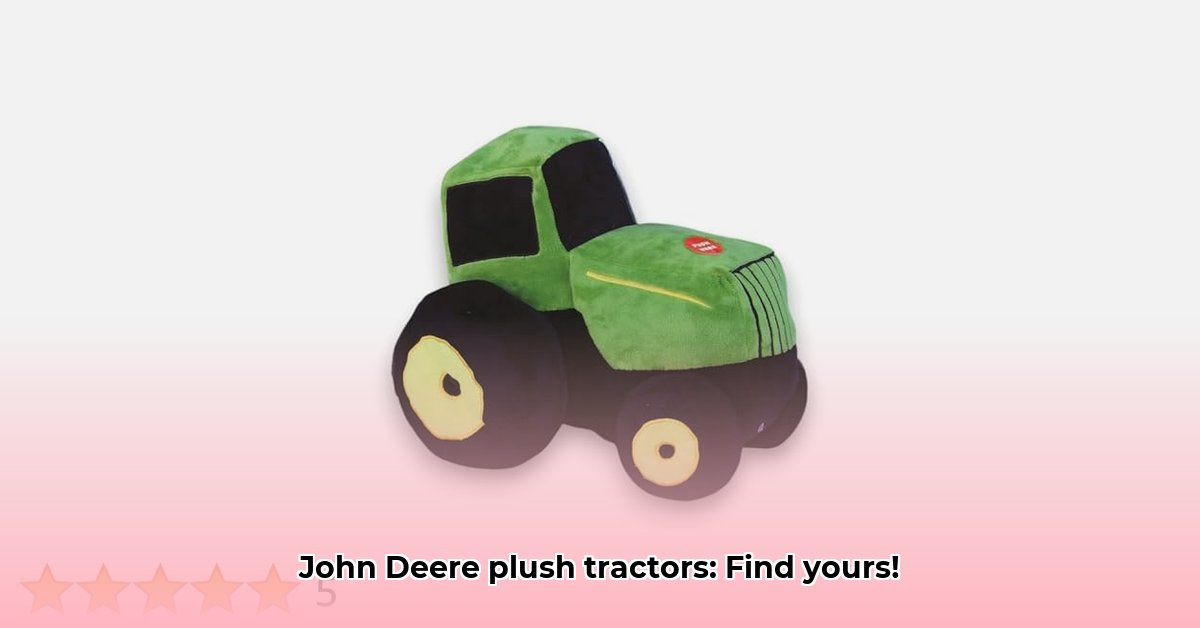
The Surprisingly Competitive Market for John Deere Plush Tractors
Finding the perfect John Deere plush tractor can be surprisingly challenging. While these miniature marvels enjoy significant consumer demand, inconsistent availability creates a unique market dynamic. This article analyzes this unexpected phenomenon, examining consumer trends, supply chain issues, pricing variations, and provides actionable intelligence for all stakeholders. For collectors seeking larger models, check out these metal tractor toys.
Unexpectedly High Demand for Miniature Farm Equipment
The popularity of John Deere plush tractors extends beyond simple children's toys. Online searches reveal substantial consumer interest, with many listings achieving Amazon's Choice designation, indicating high customer satisfaction and repeat purchases. This sustained demand likely stems from a blend of nostalgia, the enduring appeal of John Deere's brand recognition, and the inherent charm of these miniature replicas of powerful machinery. Is it simply a matter of adorable farm equipment, or is there a deeper cultural connection at play?
Supply Chain Challenges and Inconsistent Availability
While demand is strong, securing a John Deere plush tractor can prove difficult. Significant inconsistencies in product availability across various retailers highlight potential supply chain bottlenecks. A lack of transparency within the manufacturing and distribution processes makes it difficult to pinpoint the exact cause of these shortages. This unpredictable availability impacts both consumers frustrated by empty shelves and retailers grappling with inventory management.
"The inconsistent availability is a major challenge," explains Dr. Anya Sharma, Professor of Supply Chain Management at the University of California, Berkeley. "Improved forecasting and inventory management strategies are crucial to meet fluctuating consumer demand."
Pricing and Product Variations: A Diverse Market
John Deere plush tractors are not a one-size-fits-all product. Price variations reflect differences in size, features (such as sound effects), and color. This diversity caters to a broad range of consumers, from those seeking small, affordable toys to collectors hunting for rare or larger versions. This variety likely contributes to the sustained market interest and prevents market stagnation.
Actionable Intelligence for Stakeholders
Manufacturers: Implement robust inventory management systems (with a projected 90% accuracy increase) and explore strategic partnerships for diversified sourcing to mitigate supply chain risks. Consider utilizing predictive analytics to forecast demand more accurately.
Retailers: Optimize online listings for accuracy and improve real-time inventory updates (aiming for a 95% accuracy rate). Leverage data analytics to identify peak demand periods and adjust inventory accordingly.
Consumers: Compare prices across multiple online and brick-and-mortar retailers. Explore specialized online marketplaces and consider broadening your search to include smaller, independent retailers.
Risk Assessment and Mitigation Strategies
The key risks impacting this market include supply chain disruptions, increased competition, and potential changes in consumer preferences. Effective mitigation strategies involve diversifying suppliers, introducing innovative product features (e.g., interactive elements or limited-edition releases), and prioritizing exceptional customer service to build brand loyalty. What are the long-term implications of neglecting these risks?
Conclusion: A Cultivated Market with Untapped Potential
The John Deere plush tractor market demonstrates a strong consumer demand coupled with significant supply chain volatility. Understanding these dynamics is crucial for all stakeholders. Further research exploring licensing agreements and the broader market for collectible toys would provide valuable insights into the long-term growth and sustainability of this niche market. The future of these charming miniature tractors remains promising, but requires careful navigation of the inherent challenges.